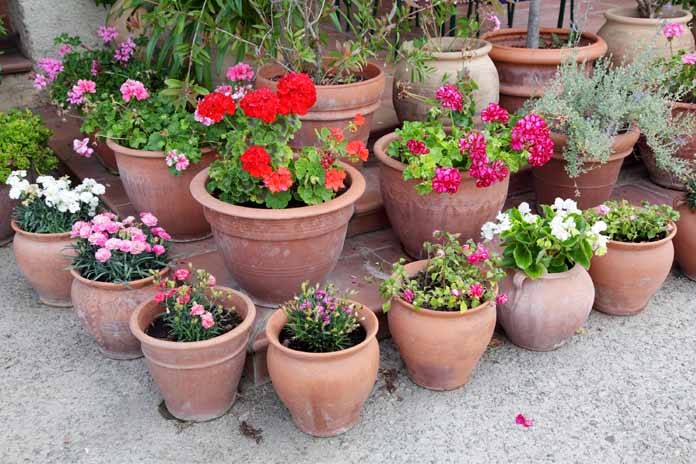
Container gardening is an excellent way to produce a variety of foods locally. This type of gardening is easy, can be used indoors or outdoors, is eco-friendly and keeps your family healthier. If you are new to using containers for gardening, use these tips and strategies. Plus container gardening is perfect option for flowering indoor plants.
Also Read: How Gardening Is Good For Your Health!
Contents
Choosing the Containers
There’s a diverse variety of containers for gardening to choose from. You can start with smaller containers if urban gardening interests you or get larger containers if you want more room for the produce to grow. Some varieties include,
- Plastic containers- Best known for retaining moisture. Terracotta pots are certainly the most attractive ones.
- Wooden Containers- Provide cheap insulation. Go for the ones that are made of redwood or cedar, as they are rot resistant.
- Reusable Containers- Go green while gardening with old plastic containers and coffee containers. Avoid using any container that has been treated with chemicals, as this could be hazardous for your plants.
- Containers made of composted cow manure make excellent garden containers as well.
Gathering Your Gear
Container gardening does not require much regarding gear. You need gloves and shears, a trowel, and a hand fork. Remember to keep your tools clean and blades sharp. Another important element that forms an essential part of the gear is the potting mix. It is essential because regular ground soul may have weeds or disease. Such soil may also lack proper nutrients or water-retention capacities.
Also Read: 13 Gardening Tips You Should Follow, #10 is Stunning
Creating Your Potting Mix
Buy a pre-potting mix or save a lot of money by making one on your own. It is easy to do! Get hold of 1 part coir peat, 1 part vermiculite, and two parts compost and follow this process,
- Most of the packets of coir peat contain instructions on how to rehydrate it. Follow those instructions to achieve the task of soaking.
- Mix coir peat and vermiculite and then slowly add the compost to the mixture.
- To make the mix more fertile, add ½-1 cup of worm castings before container planting.
Picking right plants
A large number of plants are well-suited for container gardening. These includes fruits, vegetables, herbs, and flowers. Some of the commonly grown plants are as follows;
- Fruits – Figs, Peaches, Pear, Grapes, and Strawberries
- Vegetables – Mushrooms, Beans, Kale, Onions, Potatoes, Carrots, Radishes, Spinach, and Lettuces.
- Herbs – Basil, Chives, Cilantro, Tarragon, Rosemary, Thyme, Lemon Verbena, Oregano, Sage, and Mint.
- Flowers – Calendula, Snapdragon, White Cyclamen, Heuchera, Chamomile, Daffodils, and Dahlias.
Developing a system
Depending on the size of your container garden, you will need to create a garden system, allowing optimum growth of your plants. Set up container gardens at a place that receives adequate sunlight and air, preferably near east or west facing windows or balconies.
For larger container gardens you may need to setup a shelving system with properly controlled environmental factors like light, temperature and water frequency. Fluorescent lights and drip system with heat pads at the bottom of the planters will be required for this purpose.
Group plants by how much sunlight and water they need. For instance, tomatoes can be grouped with radishes and eggplants, but mushrooms require no sunlight and should be grouped separately.
Maintenance
- After planting a container garden, you need to maintain them for a better produce and harvest. Ensure that plants are receiving adequate amounts of sunlight and water and that their soil temperatures are rightly maintained in the range of 75–85 °F.
- When your plants grow up to become too large, then transfer them into bigger containers or split them into several plants, so that they have enough space to grow further. Failing to do so will inhibit their growth and cause damage.
- If you see any brown spots on any of the plants or if any of them is clearly dying, you should promptly remove them from others as they may be carrying diseases or pests that might spread. Plant good, healthy neighbors for each plant and add tags to them for better identification.
- Every few months, incorporate compost or fertilizer into the gardening containers to keep up the supply of essential nutrients for the plants.
Maximizing Drainage
One of the primary causes for the failure of container gardening is under or over watering. It is a thumb rule that you should not let the plant sit in accumulated water. So, always get containers for gardening that have a hole in the bottom for allowing discharge of excess water or simply create by one by drilling a hole into any container.
Remember, container gardening requires hard work, but the produce is all worth it! You will find it very rewarding. However, you should ensure that you get the right plants and harvest them on time. Before diving in with this gardening, assess your living situation and start small. All the best.
Also Read: Top 10 Indoor Gardening Tips You Must Try
